Physical Address
304 North Cardinal St.
Dorchester Center, MA 02124
![]() Additional content is available online at Elsevier eBooks for Practicing Clinicians
Additional content is available online at Elsevier eBooks for Practicing Clinicians
The 20th century witnessed a remarkable evolution in concepts concerning the pathogenesis of atherosclerosis. This disease has a venerable history, having left traces in the arteries of mummies. , Atherosclerosis became epidemic as populations increasingly survived early mortality associated with communicable diseases and malnutrition. Economic development and urbanization promoted poor diet (e.g., a surfeit of saturated fats) and diminished physical activity, which can favor atherogenesis. These environmental factors have spread steadily, such that we face an epidemic of atherosclerosis that reaches far beyond Western societies.
Views of the pathogenesis of atherosclerosis have evolved considerably over time ( Fig. 24.1 ). In the mid-19th century, Rudolf Virchow recognized the participation of cells in atherogenesis. A controversy raged between Virchow, who viewed atherosclerosis as a proliferative disease, and Carl von Rokitansky, who believed that atheroma derived from healing and resorption of thrombi. Experiments were performed in the early part of the 20th century using dietary modulation to produce fatty lesions in the arteries of rabbits and ultimately identified cholesterol as the culprit. These observations, followed by the characterization of human lipoprotein particles in the mid-20th century, found that lipids are a cause for atherosclerosis. Elements of all these mechanisms indeed contribute to atherogenesis. This chapter summarizes evidence from human studies, animal experimentation, and in vitro work and presents a synoptic view of atherogenesis from the biologic perspective.
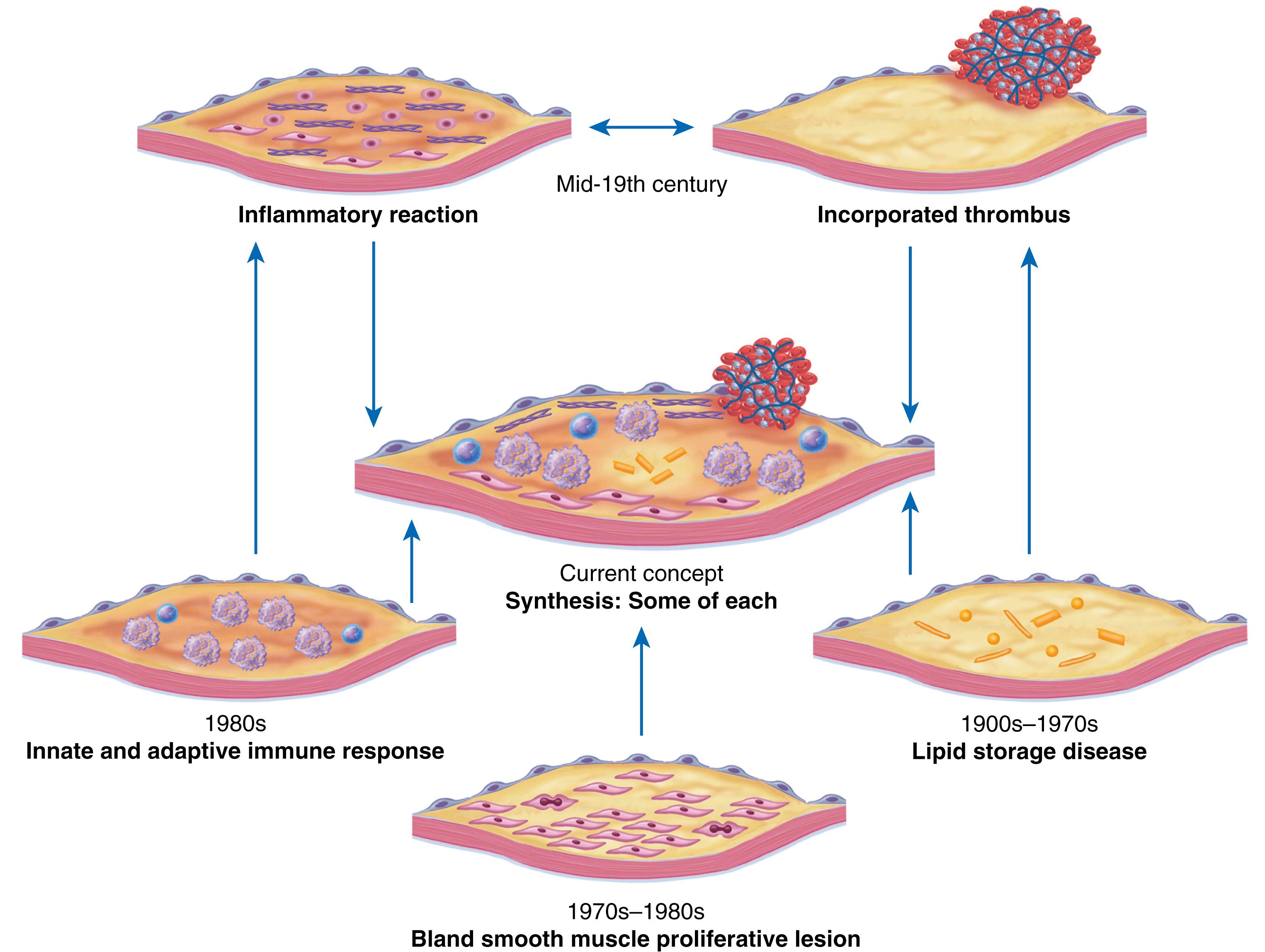
Acquaintance with the vascular biology of atherosclerosis should prove useful to the practitioner. Our daily contact with this common disease lulls us into a complacent belief that we understand it better than we actually do. For example, we have begun to understand why atherosclerosis affects certain regions of the arterial tree preferentially and why its clinical manifestations occur only at certain times. Despite systemic exposure to risk factors such as dyslipidemia and hypertension and smoking, atherosclerosis preferentially produces focal stenoses in certain locations.
Atherosclerosis also displays dispersion in time; this disease has both chronic and acute manifestations. Few human diseases have a longer “incubation” period than atherosclerosis, which begins to affect the arteries of many Americans in the second and third decades of life. Indeed, many young Americans often have abnormal thickening of the coronary arterial intima; yet typically, symptoms of atherosclerosis emerge only after several decades of delay, characteristically appearing even later in women. Despite this indolent time course and prolonged period of clinical inactivity, the dreaded complications of atheroma—myocardial infarction (MI) and stroke—often occur suddenly and without warning.
Another poorly understood aspect of atherogenesis is its role in the narrowing, or stenosis, of some vessels and in the dilation or ectasia of others. Traditionally, cardiologists have focused on stenoses in coronary arteries, but atherosclerosis can also commonly manifest as aneurysms, as in the aorta. Even in the life history of a single atherosclerotic lesion, a phase of ectasia known as positive remodeling, or compensatory enlargement, precedes the formation of stenotic lesions. Contemporary vascular biology has begun to shed light on some of these puzzling aspects of atherosclerosis.
The endothelial cell (EC) of the arterial intima constitutes the crucial contact surface with blood. Arterial ECs possess many highly regulated mechanisms of capital importance in vascular homeostasis that often go awry during the pathogenesis of arterial diseases. For example, the EC provides one of the only surfaces, either natural or synthetic, that can maintain blood in a liquid state during protracted contact ( Fig. 24.2 ). This remarkable blood compatibility derives in part from the expression of heparan sulfate proteoglycan molecules on the surface of the EC. Like heparin, these molecules, can serve as a cofactor for antithrombin III, causing a conformational change that allows this inhibitor to bind to and inactivate thrombin. The surface of the EC also contains thrombomodulin, which binds thrombin molecules and can exert antithrombotic properties by activating proteins S and C. Should a thrombus begin to form, the normal EC possesses potent fibrinolytic mechanisms associated with its surface. The EC can produce both tissue-plasminogen activator (t-PA) and urokinase-type plasminogen activator (u-PA). These enzymes—t-PA and u-PA—catalyze the activation of plasminogen into plasmin, a fibrinolytic enzyme. (See Chapter 95 for a complete discussion on the role of the endothelium in hemostasis and fibrinolysis.)
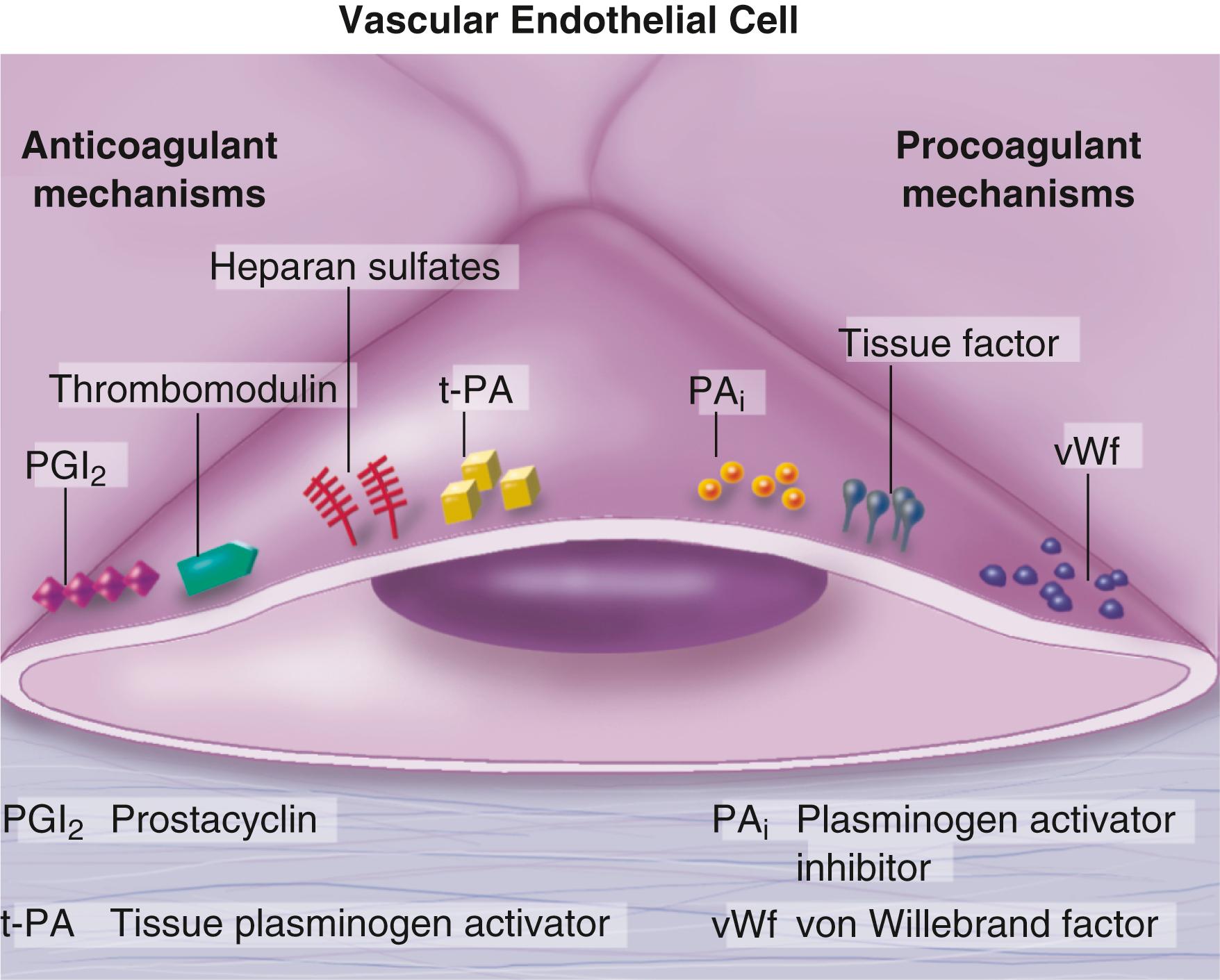
ECs have a common origin but are considerably heterogeneous. The use of single cell analyses has increased appreciation of the functional attributes and anatomic distribution of three to four distinct EC populations. An example from mouse atheroma shows EC populations expressing genes implicated in lipid handling, angiogenesis, and lymph functions ( Fig. 24.3 ).
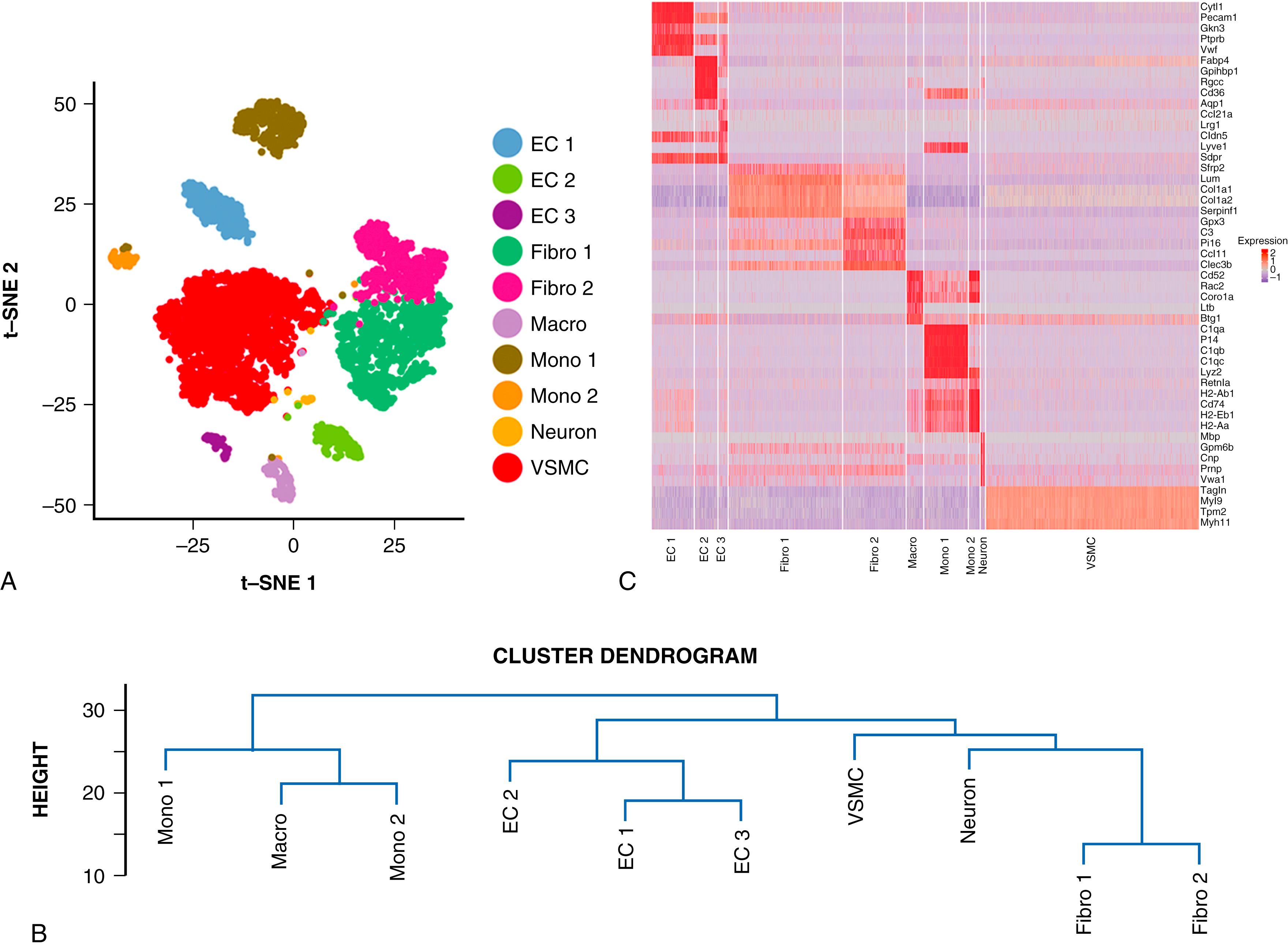
The second major cell type of the normal artery wall, the smooth muscle cell (SMC), has many important functions in normal vascular homeostasis, as a target of therapies in cardiovascular medicine and in the pathogenesis of arterial diseases. These cells contract and relax and thus control blood flow through the various arterial beds, generally at the level of the muscular arterioles. However, in larger arteries involved in atherosclerosis, abnormal smooth muscle contraction may cause vasospasm, a complication of atherosclerosis that may impede blood flow. SMCs synthesize the bulk of the complex arterial extracellular matrix (ECM) that plays a key role in normal vascular homeostasis and in the formation and complication of atherosclerotic lesions. These cells also can migrate and proliferate, contributing to the formation of intimal hyperplastic lesions, including atherosclerosis and restenosis; stent stenosis after percutaneous intervention; or anastomotic hyperplasia, complicating vein grafts. Death of SMCs may promote destabilization of atheromatous plaques or may favor ectatic remodeling and ultimately aneurysm formation.
In contrast with ECs, which are thought to come from a common precursor, SMCs can arise from many sources. After ECs form tubes, the rudimentary precursor of blood vessels, they recruit the cells that will become SMCs or pericytes (smooth muscle–like cells associated with microvessels). In the descending aorta and arteries of the lower body, the regional mesoderm serves as the source of smooth muscle precursors. The mesodermal cells in somites give rise to the SMCs that make up much of the distal aorta and its branches. However, in arteries of the upper body, SMCs can derive from a completely different germ layer—the neuroectoderm, rather than mesoderm. Also, the precursors of coronary artery SMCs arise from another embryologic source, a structure known as the proepicardial organ.
The heterogeneity of SMCs may have direct clinical implications to help understand several common observations, such as the propensity of certain arteries or regions of arteries to develop atherosclerosis or heightened responses to injury (e.g., proximal left anterior descending coronary artery), and medial degeneration (e.g., proximal aorta in Marfan syndrome). Differential responses of SMCs to regulators of ECM production help explain why the clinical manifestations of systemic defects in fibrillin and elastin characteristically occur locally in the ascending aorta. The plasticity of SMCs may even give rise to cells with characteristics and functions of mononuclear phagocytes in murine atherosclerotic plaques. , SMCs can expand clonally in atheromata, exert proinflammatory functions, and contribute to formation of the plaques’ necrotic core, as discussed below.
An understanding of the pathogenesis of atherosclerosis first requires knowledge on the structure and biology of the normal artery and its indigenous cell types. Normal arteries have a well-developed trilaminar structure ( Fig. 24.4 ). The innermost layer, the tunica intima, is generally thin at birth in humans and in many nonhuman species. Although it is often depicted as a monolayer of ECs abutting directly on a basal lamina, the adult human intima actually has a much more complex and heterogeneous structure. The endothelial monolayer resides on a basement membrane containing nonfibrillar collagen types, such as type IV collagen, laminin, fibronectin, and other ECM molecules. With aging, human arteries develop a more developed intima containing arterial SMCs and fibrillar forms of interstitial collagen (types I and III). SMCs produce these ECM constituents of the arterial intima. Most adult human arteries have a more complex intima, known by pathologists as “diffuse intimal thickening.” Some locales in the arterial tree tend to develop a thicker intima than other regions, even in the absence of atherosclerosis ( Fig. 24.5 ). For example, the proximal left anterior descending coronary artery often contains a more fully developed diffuse intimal thickening or an intimal cushion of SMCs than that in typical arteries. The diffuse intimal thickening process does not necessarily go hand in hand with lipid accumulation and may occur in persons without a substantial burden of atheroma. The internal elastic membrane binds the tunica intima abluminally and serves as the border between the intimal layer and the underlying tunia media.
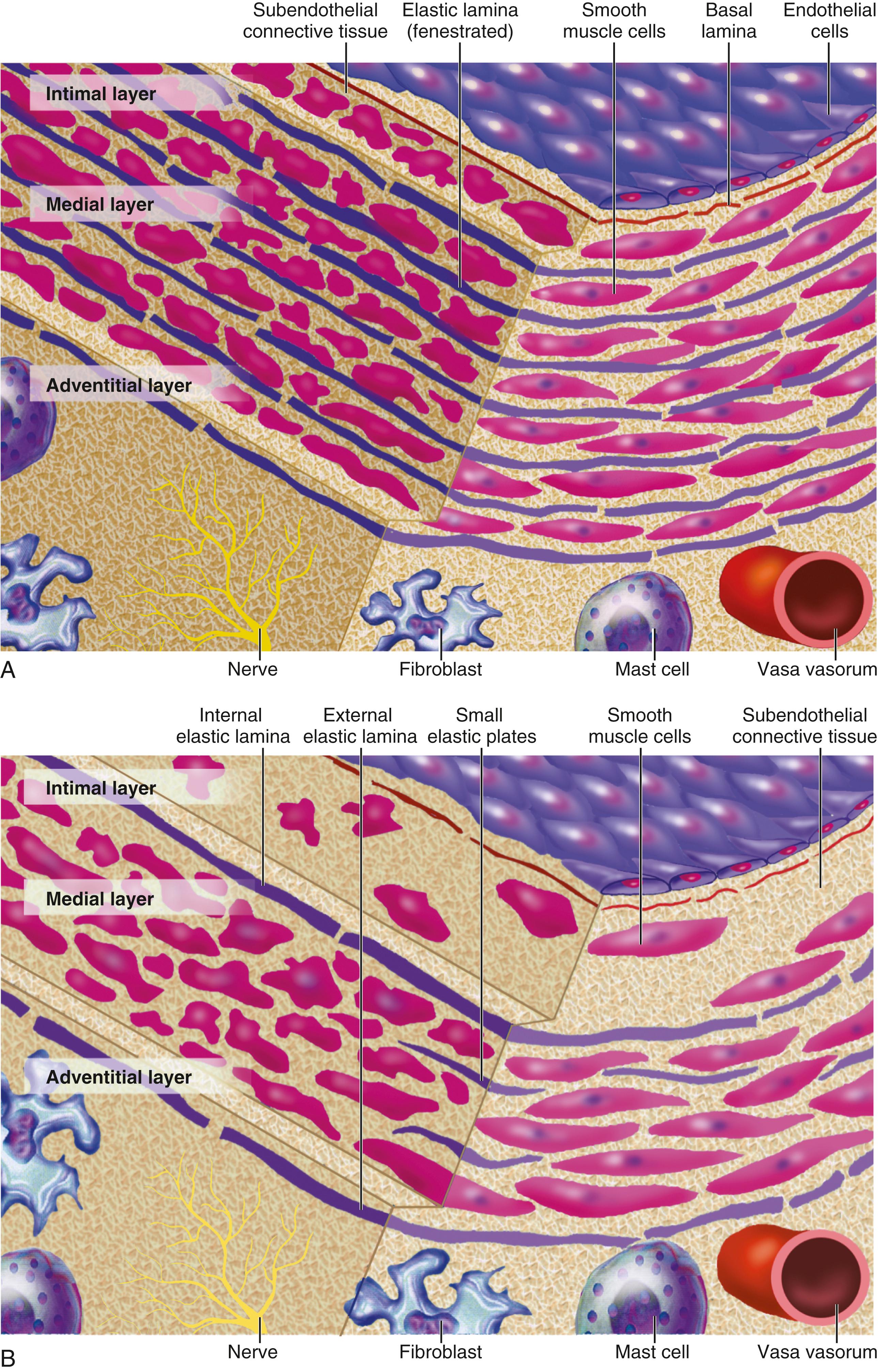
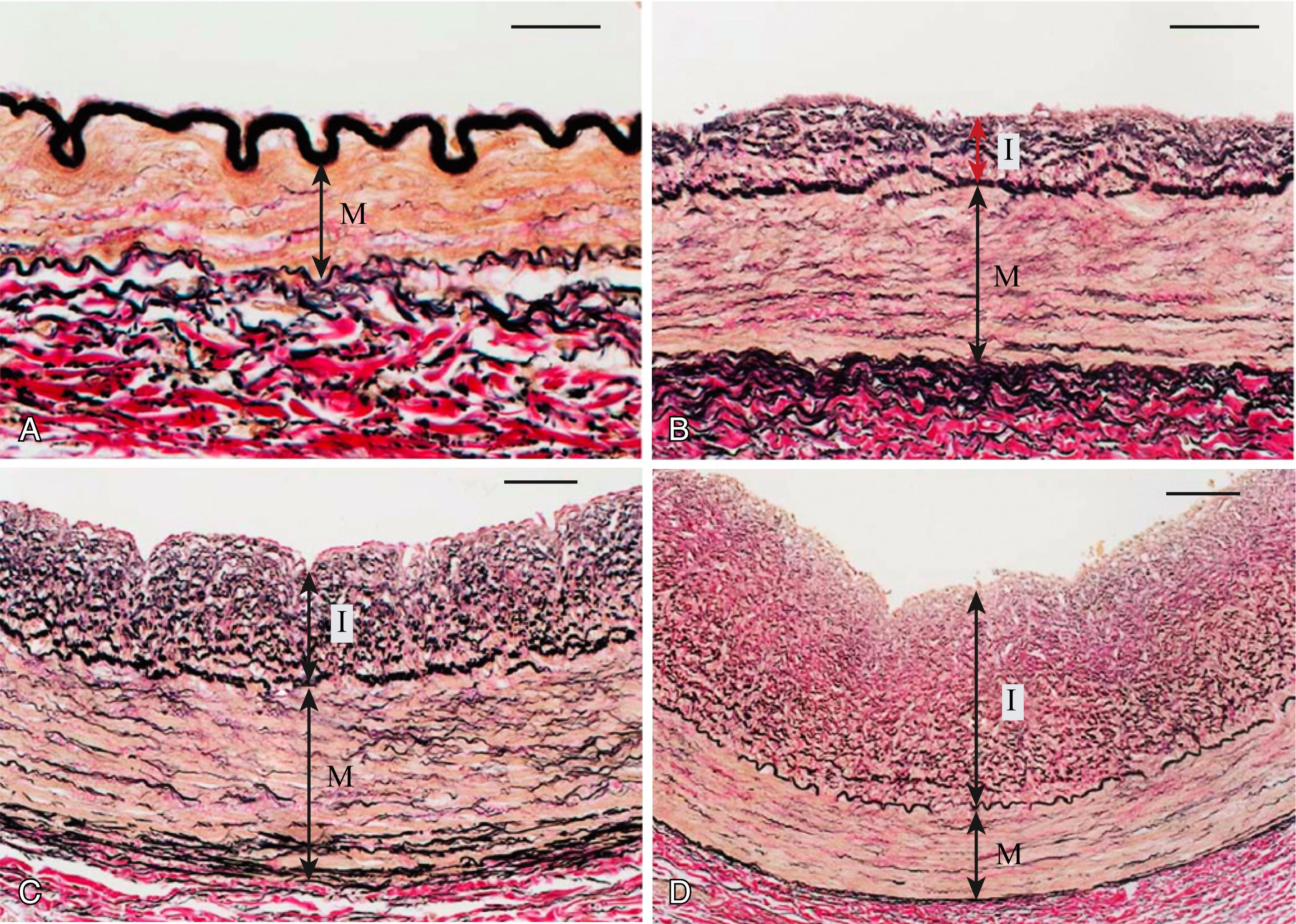
The tunica media lies under the intima and internal elastic lamina. Like in the aorta, the media of elastic arteries has well-developed concentric layers of SMCs, interleaved with layers of elastin-rich ECM (see Fig. 24.4 ). This structure appears well adapted to the storage of the kinetic energy of left ventricular systole by the walls of great arteries. The lamellar structure also certainly contributes to the structural integrity of the arterial trunks. The media of smaller muscular arteries usually has a less stereotypic organization. SMCs in these smaller arteries generally embed in the surrounding matrix in a more continuous than lamellar array. The SMCs in normal arteries seldom proliferate. Indeed, under usual circumstances, the rates of cell division and cell death are low. In the normal artery, a state of ECM homeostasis also typically prevails: rates of arterial matrix synthesis and dissolution usually balance each other. The external elastic lamina bounds the tunica media abluminally, forming the border with the adventitial layer.
The adventitia of arteries typically has received little attention, although appreciation of its potential roles in arterial homeostasis and pathology has increased. The adventitia contains collagen fibrils in a looser array than that usually encountered in the intima. Vasa vasorum and nerve endings localize in this outermost layer of the arterial wall. The cellular population in the adventitia is sparser than in other arterial layers. Cells found in this layer include fibroblasts and mast cells (see Fig. 24.4 ). Emerging evidence suggests a role for mast cells in atheroma and aneurysm formation in animal models, but their importance in humans remains speculative. The adventitia also contains aggregates of lymphocytes known as tertiary lymphoid organs that may contribute to local periarterial immune responses.
The first steps in human atherogenesis remain largely conjectural, but the integration of observations of tissues obtained from young humans with the results of experimental studies of atherogenesis in animals provides hints in this regard. On initiation of an atherogenic diet, typically rich in cholesterol and saturated fat, small lipoprotein particles accumulate in the intima ( Fig. 24.6 , steps 1 and 2). These lipoprotein particles appear to decorate the proteoglycan of the arterial intima and tend to coalesce into aggregates ( Fig. 24.7 ). Detailed kinetic studies of labeled lipoprotein particles indicate that a prolonged residence time characterizes sites of early lesion formation in rabbits. The binding of lipoproteins to proteoglycan in the intima leads to their capture and retention, accounting for their prolonged residence time. Lipoprotein particles bound to proteoglycan have increased susceptibility to oxidative or other chemical modifications, considered by many to contribute to the pathogenesis of early atherosclerosis (step 2 in Fig. 24.6 ). Other studies suggest that permeability of the endothelial monolayer increases at sites of lesion predilection to low-density lipoprotein (LDL). Contributors to oxidative stress in the nascent atheroma include nicotinamide adenine dinucleotide/nicotinamide adenine dinucleotide phosphate (NADH/NADPH) oxidases expressed by vascular cells, lipoxygenases expressed by infiltrating leukocytes, or the enzyme myeloperoxidase.
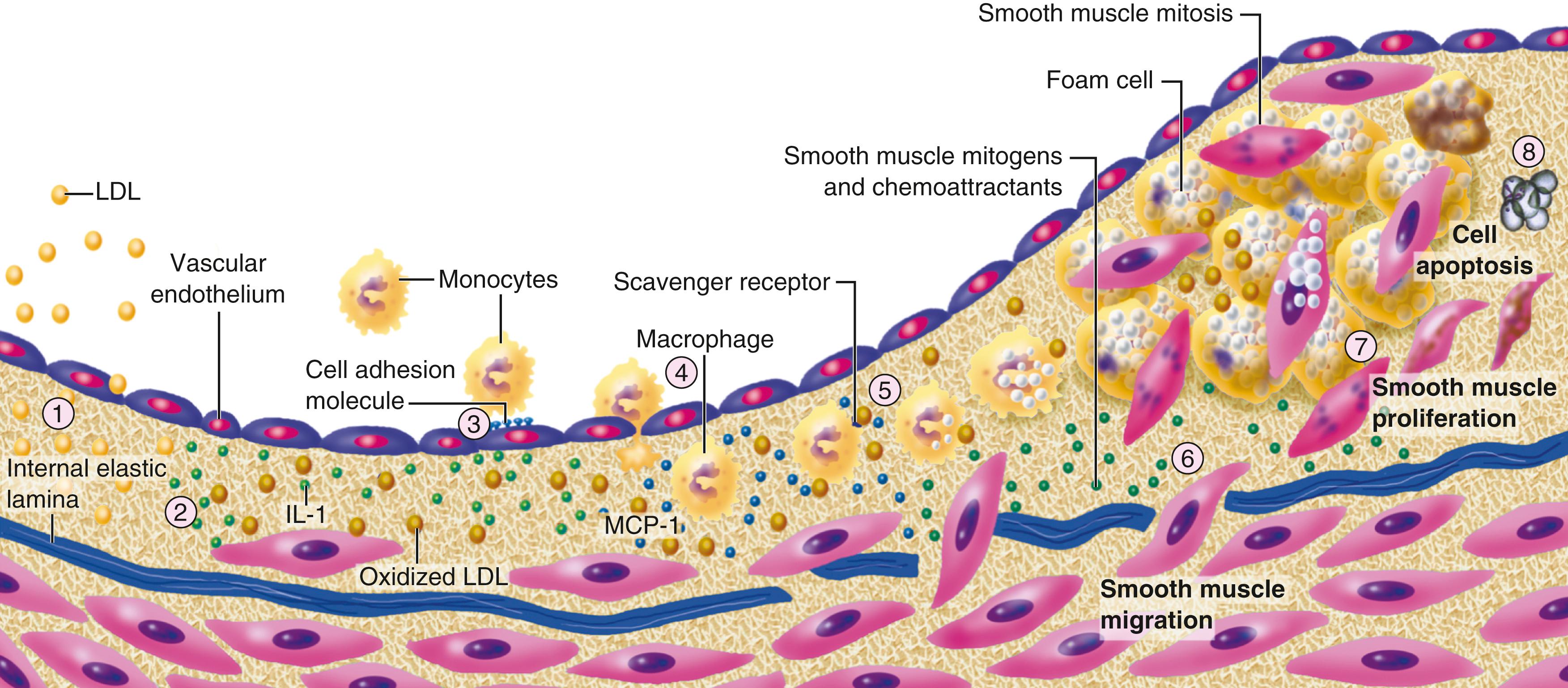
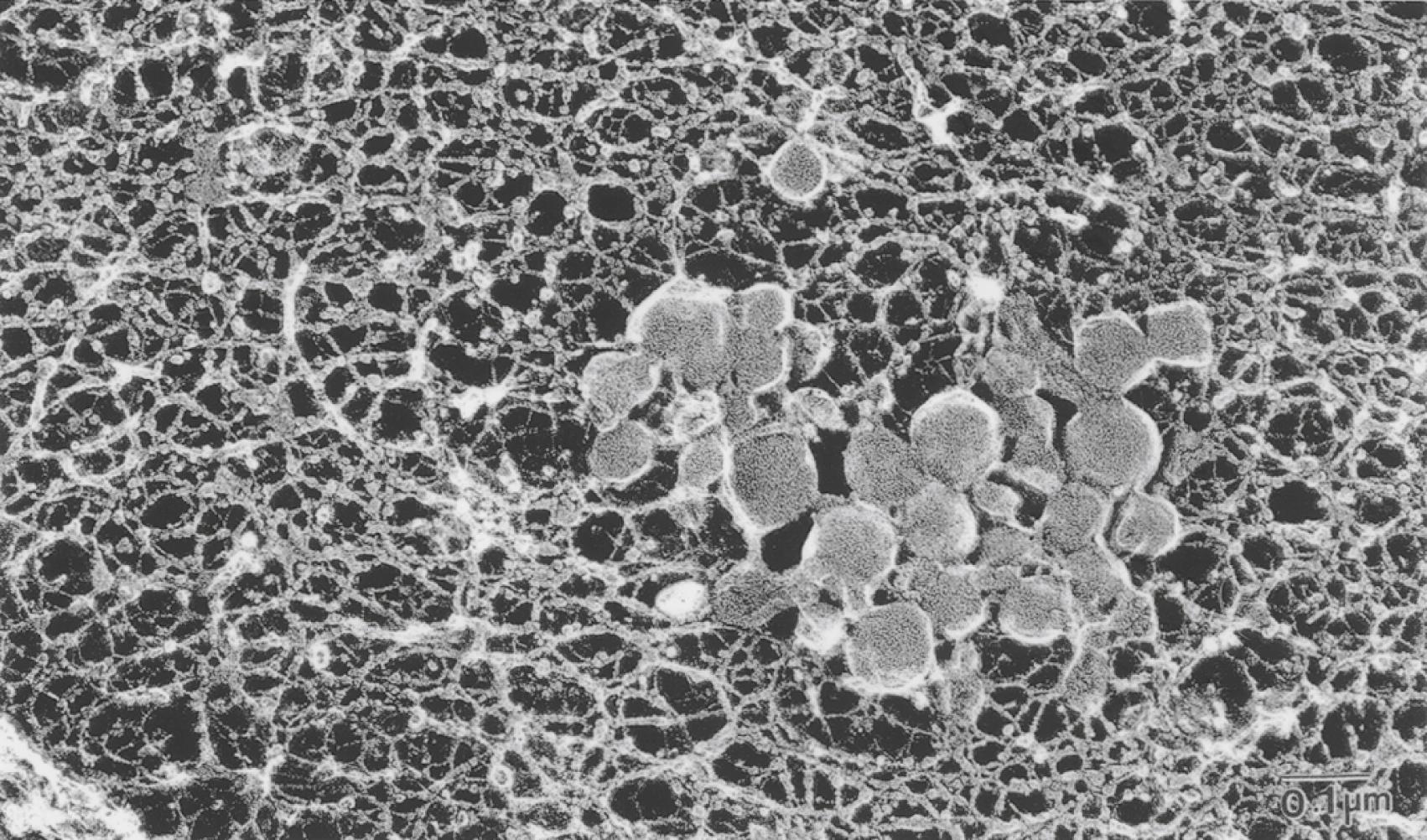
Another hallmark of atherogenesis is leukocyte recruitment and accumulation (step 4 in Fig. 24.6 ), also occurs early in lesion generation ( Fig. 24.8 ). The normal EC generally resists adhesive interactions with leukocytes. Even in inflamed tissues, most recruitment and trafficking of leukocytes occurs in postcapillary venules and not in arteries. However, very soon after initiation of hypercholesterolemia, leukocytes adhere to the endothelium and move between EC junctions, or even penetrate through ECs (transcytosis) to enter the intima, where they begin to accumulate lipids and become foam cells (step 5 in Fig. 24.6 ). In addition to the monocyte, T lymphocytes also tend to accumulate in early human and animal atherosclerotic lesions. The expression of certain leukocyte adhesion molecules on the surface of the EC regulates the adherence of monocytes and T cells to the endothelium. Several categories of leukocyte adhesion molecules exist. Members of the immunoglobulin (Ig) superfamily include vascular cell adhesion molecule-1 (VCAM-1), or cluster of differentiation (CD)106. This adhesion molecule is of particular interest in the context of early atherogenesis because it interacts with an integrin, very late antigen-4 (VLA-4), characteristically expressed by only those classes of leukocytes that accumulate in nascent atheroma—monocytes and T cells. Moreover, experimental studies have shown expression of VCAM-1 on ECs overlying very early atheromatous lesions. Other members of the Ig superfamily of leukocyte adhesion molecules include intercellular adhesion molecule-1 (ICAM-1). This molecule is more promiscuous in the types of leukocytes it binds and in its wide and constitutive expression at low levels by ECs in many parts of the circulation.
![FIGURE 24.8, Endothelial proinflammatory activation. In lesion-prone regions of the arterial vasculature, the actions of proinflammatory agonists (e.g., interleukin [IL]-1, tumor necrosis factor [TNF], and endotoxin), oxidized lipoproteins (Ox-LDL) and advanced glycation end products (AGE), and biomechanical stimulation by disturbed blood flow, leads to endothelial activation. These biochemical and biomechanical stimuli signal predominantly via the pleiotropic transcription factor nuclear factor-κB (NF-κB), resulting in a coordinated program of genetic regulation within the endothelial cell. This includes the cell surface expression of adhesion molecules (e.g., vascular cell adhesion molecule-1 [VCAM-1]), secreted and membrane-associated chemokines (e.g., monocyte chemoattractant protein [MCP]-1 and fractalkine), and prothrombotic mediators (e.g., tissue factor [TF], von Willebrand Factor [vWF], and the inhibitor of fibrinolysis plasminogen activator inhibitor [PAI]-1). These events foster the selective recruitment of monocytes and various types of T lymphocytes, which become resident in the subendothelial space. The concerted actions of activated endothelial cells, smooth muscle cells, monocyte/macrophages, and lymphocytes result in the production of a complex paracrine milieu of cytokines, growth factors, and reactive oxygen species (ROS) within the vessel wall, which perpetuates a chronic proinflammatory state and fosters atherosclerotic lesion progression. IL-R, TNF-R indicates receptor(s) for IL-1, TNF; Ox-LDL-R, receptor for oxidized LDL; RAGE, receptor for AGE; TLRs, Toll-like receptors. FIGURE 24.8, Endothelial proinflammatory activation. In lesion-prone regions of the arterial vasculature, the actions of proinflammatory agonists (e.g., interleukin [IL]-1, tumor necrosis factor [TNF], and endotoxin), oxidized lipoproteins (Ox-LDL) and advanced glycation end products (AGE), and biomechanical stimulation by disturbed blood flow, leads to endothelial activation. These biochemical and biomechanical stimuli signal predominantly via the pleiotropic transcription factor nuclear factor-κB (NF-κB), resulting in a coordinated program of genetic regulation within the endothelial cell. This includes the cell surface expression of adhesion molecules (e.g., vascular cell adhesion molecule-1 [VCAM-1]), secreted and membrane-associated chemokines (e.g., monocyte chemoattractant protein [MCP]-1 and fractalkine), and prothrombotic mediators (e.g., tissue factor [TF], von Willebrand Factor [vWF], and the inhibitor of fibrinolysis plasminogen activator inhibitor [PAI]-1). These events foster the selective recruitment of monocytes and various types of T lymphocytes, which become resident in the subendothelial space. The concerted actions of activated endothelial cells, smooth muscle cells, monocyte/macrophages, and lymphocytes result in the production of a complex paracrine milieu of cytokines, growth factors, and reactive oxygen species (ROS) within the vessel wall, which perpetuates a chronic proinflammatory state and fosters atherosclerotic lesion progression. IL-R, TNF-R indicates receptor(s) for IL-1, TNF; Ox-LDL-R, receptor for oxidized LDL; RAGE, receptor for AGE; TLRs, Toll-like receptors.](https://storage.googleapis.com/dl.dentistrykey.com/clinical/TheVascularBiologyofAtherosclerosis/7_3s20B9780323722193000244.jpg)
Selectins constitute the other broad category of leukocyte adhesion molecules. The prototypic selectin, E-selectin or CD62E (E stands for “endothelial,” the cell type that selectively expresses this particular family member), probably has little to do with early atherogenesis. E-selectin preferentially recruits polymorphonuclear leukocytes, a cell type seldom found in early atheromata (but an essential protagonist in acute inflammation and host defenses against bacterial pathogens). Moreover, ECs overlying atheroma do not express high levels of this adhesion molecule. Other members of this family, including P-selectin, or CD62P (P stands for “platelet,” the original source of this adhesion molecule), may play a greater role in leukocyte recruitment in atheroma, because ECs overlying human atheroma express this adhesion molecule. Selectins tend to promote saltatory or rolling locomotion of leukocytes over the endothelium. Adhesion molecules belonging to the immunoglobulin superfamily tend to promote tighter adhesive interactions and immobilization of leukocytes. Studies in genetically altered mice have proven roles for VCAM-1 and P-selectin (including both platelet-derived and endothelium-derived P-selectin) in experimental atherosclerosis. Increasing evidence supports the accumulation in atheromas of distinct subtypes of mononuclear phagocytes. The functional consequences of this heterogeneity of macrophage populations in plaques require further study, especially in humans. , In mice, a particularly proinflammatory subset of monocytes accumulates in the spleen and peripheral blood in response to hypercholesterolemia and preferentially populates nascent atheroma.
Once adherent to the endothelium, leukocytes must receive a signal to penetrate the endothelial monolayer and enter the arterial wall (step 4 in Fig. 24.6 ). The current concept of directed migration of leukocytes involves the action of protein molecules known as chemoattractant cytokines, or chemokines. Observations on human atheroma and functional studies in vitro and in genetically altered mice point to causal roles of various chemokines in atherogenesis. In addition to recruitment, the accumulation of leukocytes in the arterial wall depends on factors that cause their retention in the intimal lesions. Retention factors include netrin-1 interacting with its receptor UNC5b (both induced by hypoxia), a protein that impairs macrophages from exiting plaques.
Become a Clinical Tree membership for Full access and enjoy Unlimited articles
If you are a member. Log in here